Affiliate disclosure: This post may contain affiliate links. Please see our Privacy Policy.
Wood chips can be incredibly helpful in the garden, provided they’re used correctly.
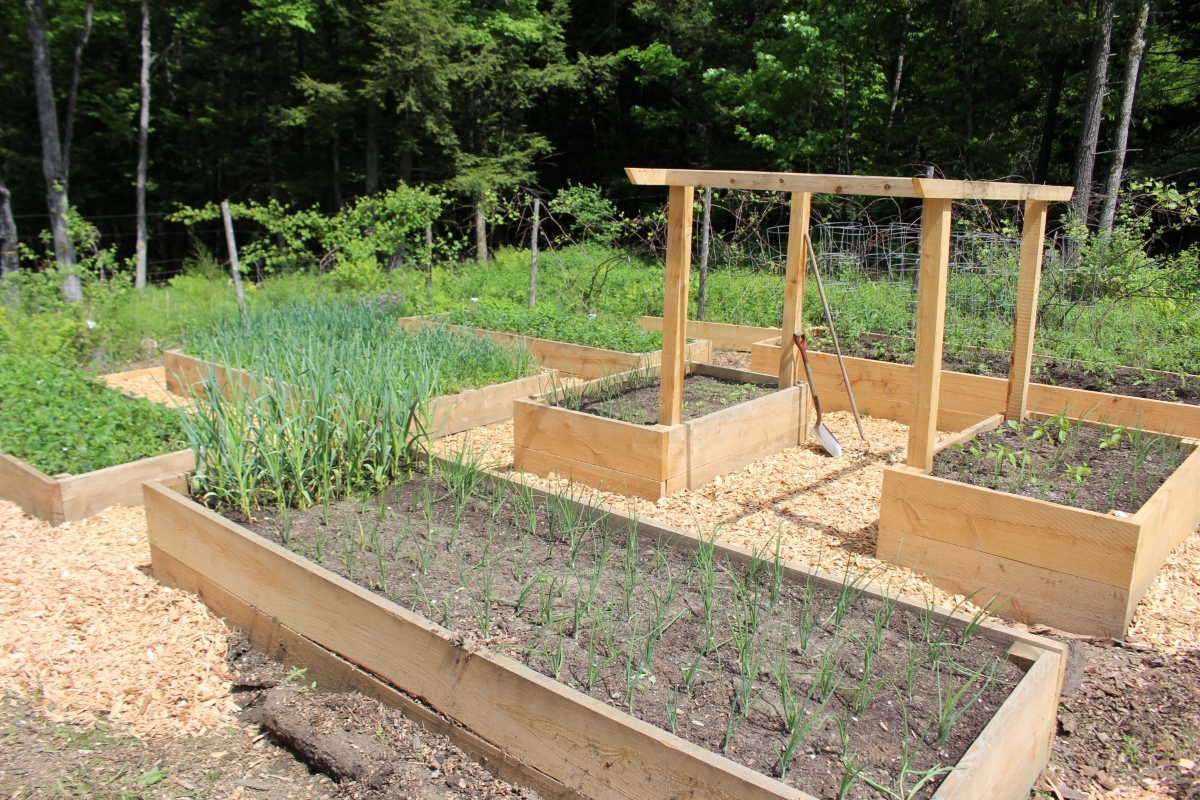
Years ago, I was walking the grounds of my friend’s permacuture education center, and he was were showing off the progress they’d made with wood chips in just a short time. It’s been just a few months since my last visit, but they’d transformed whole fields into productive ecosystems.
(Josh spent years testing different perennial agriculture systems, and he eventually wrote the book The Community-Scale Permaculture Farm.)
As Josh described the progress they’d made, it seemed like he mentioned the use of wood chips at every step. Finally, we looped back around to near where we started, and he showed me their massive new wood chipper.
“This,” he said, “is what makes it all possible!”
Gardening with wood chips allows them to save time weeding and irrigating, and the added biomatter from mushroom composted wood chips means they’re able to turn wastelands into productive gardens.
Since that walk that day, I’ve seen countless incredibly productive gardens, and more often than not, wood chips play a huge role in their management practices.
Here on our homestead, we grow as much of our food as possible, and I can honestly say that 80-90% of our productivity comes as a direct result of using gardening with woodchips and using them effectively.
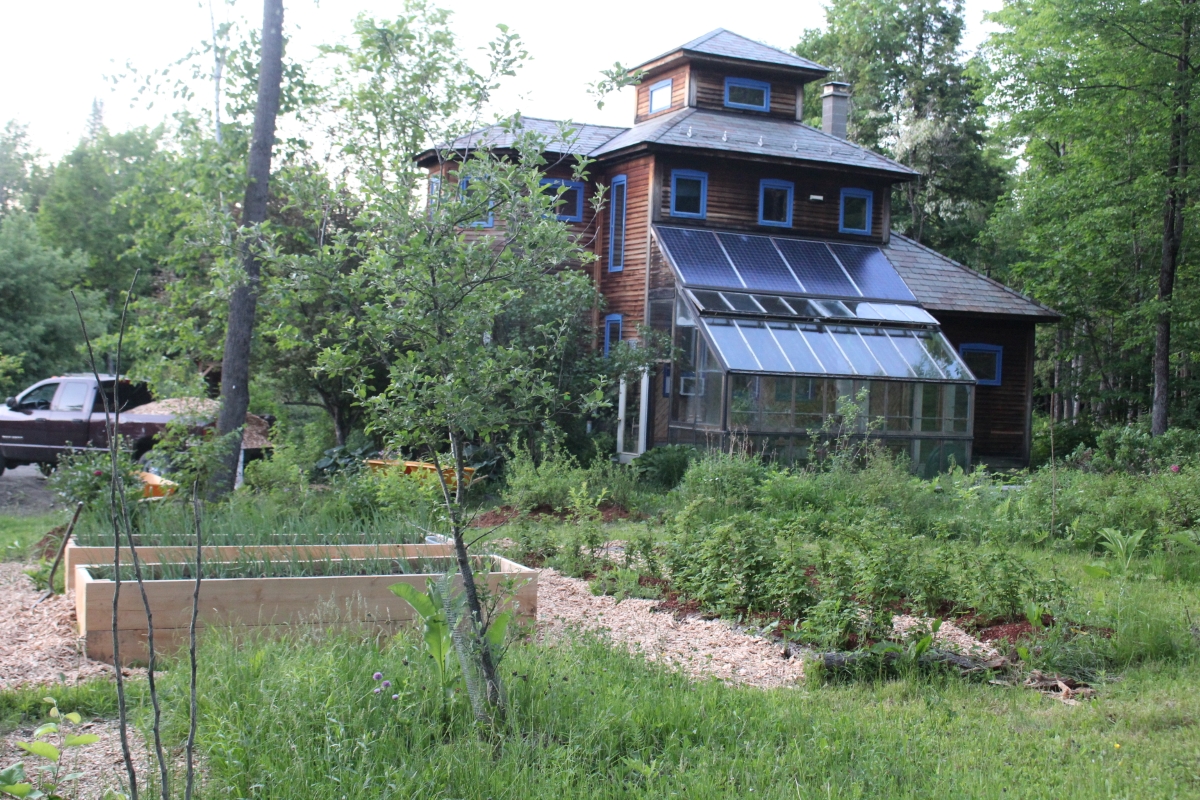
Woodchips for Mulch
Mulching with woodchips is just one of the ways to use them in the garden, but it’s perhaps easiest. The benefits of woodchip mulch, especially for perennials, are enormous:
- Weed Control – If applied in thick layers, around 2-3 inches deep, wood chips can effectively eliminate the need for weeding a garden. Commercial growers know this, but opt for plastic sheet mulch because it’s cheaper and easier to set out quickly. The problem is, plastic mulch leaches chemicals into the soil, and needs to be disposed of every few years.
- Water Retention – Wood chips help keep soil moist, preventing evaporation during the hottest parts of summer while also moderating the impact of heavy rain events. When using wood chip mulch effectively, we do not need to irrigate our plants…even through the 60+ days without rain we had this past July and August.
- Prevents Erosion – Topsoil loss is a huge issue even in small gardens, as bare soil is vulnerable to being washed away by wind and rain. While plastic mulch just diverts the water and causes localized flooding, wood chips allow the water to gently percolate through the soil, preventing erosion and minor flooding after summer thunderstorms.
- Moderating Soil Temperature – Wood chips provide insolation for the soil, which cools hot soils and warms cold ones. This is perfect for getting an early start on the year, when soil temperatures take a long time to warm sufficiently in the spring. It also helps keep plants from baking in the summer heat.
- Prevents Pests & Diseases – While woodchips don’t help with all pests, they can help with some fungal problems. Blight, for example, is caused by rain splashing soil-born fungal spores onto tomato leaves. A good thick coat of mulch can prevent this problem. Similarly, there’s evidence that wood chip mulch can help prevent other diseases, such as scab in apple trees.
- Maintaining Paths – Garden paths are prone to compaction and erosion and can become a muddy mess after rain. Woodchips help prevent all these issues, as the biological activity under woodchips (worms, microbes, etc) keeps the soil aerated and prevents compaction, and erosion and mud are prevented as the soil surface is protected by chips.
Besides their use as mulch, woodchips can also be used to create a hotbed to propagate plants as well as to grow edible mushrooms (and create valuable mushroom compost).
Woodchips can be used in both perennial gardens and annual gardens, but they’re used somewhat differently in each.
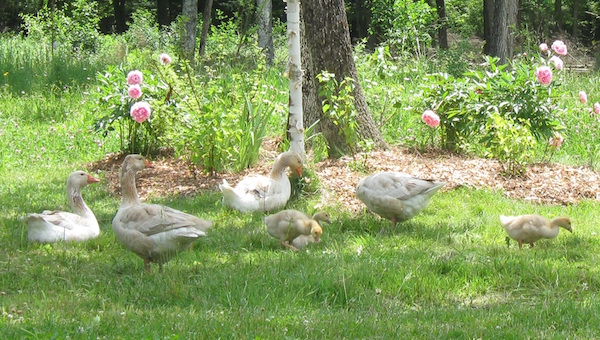
Using Woodchips on in Permaculture
We mostly focus on perennial agriculture on our homestead, or “permaculture” as it’s often called these days. We grow literally dozens of varieties of apples, pears, blueberries, and other soft fruits, along with perennial vegetables and mushrooms too.
Perennials appreciate an environment with low disturbance, and soils with what’s known as “fungal dominance.”
In soil that’s disturbed or tilled regularly, the soil ecosystem is dominated by bacteria and they’re the primary decomposers. Most compost, for example, is rich in beneficial bacteria, as is annual garden soil.
Areas with low disturbance (like woodlands and well-managed orchards) start as “bacterially dominated ecosystems” when they’re first established, but then over time they move toward “fungal dominance.” That means that mushrooms and woody decomposers take over and completely transform the soil ecosystem.
This fungal-dominated soil is what perennials prefer since it’s most commonly present in places where they can establish and thrive without disturbance for generations.
Gardening with woodchips accelerates this process and allows new perennial gardens to quickly develop healthy fungal ecosystems quite quickly. Add in the fact that woodchips prevent weeds, increase fertility and hold soil moisture and you’ve got a recipe for a thriving perennial garden.
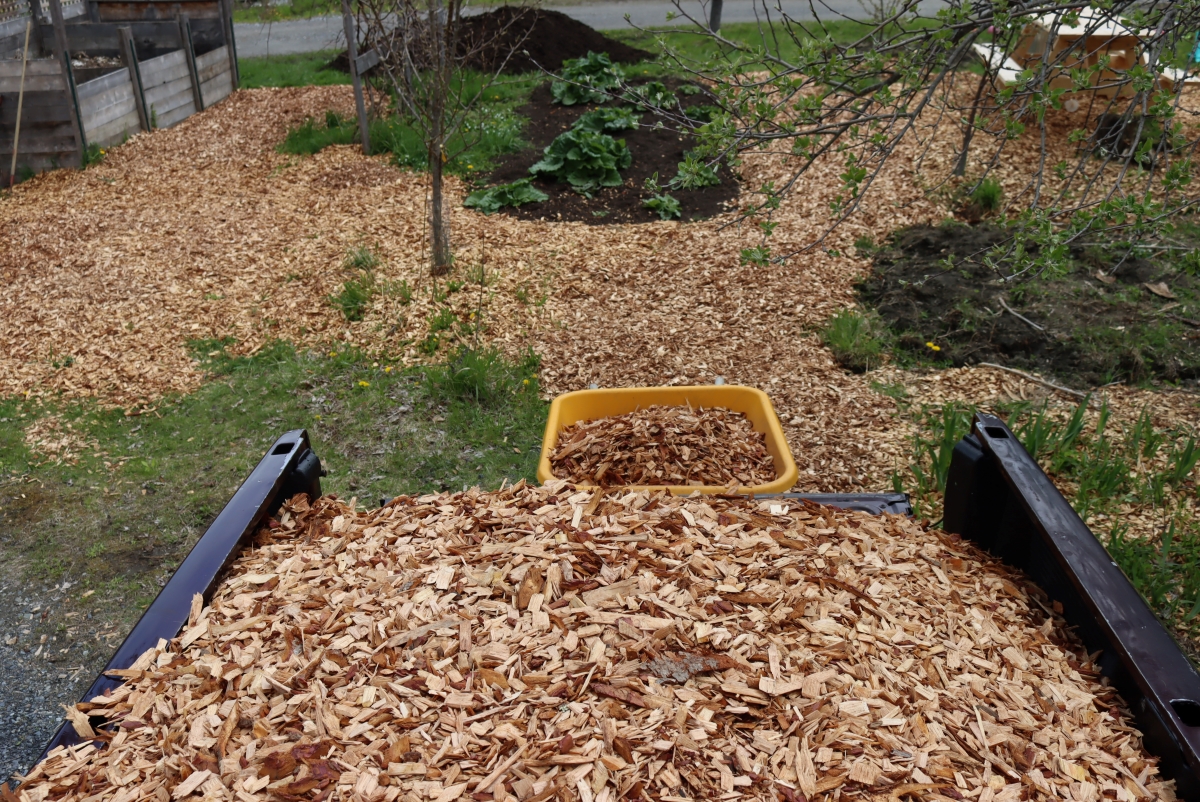
Using Woodchips in Annual Gardens
Unlike perennial crops, annual vegetables actually thrive on some level of regular soil disturbance. Gardeners regularly add compost to increase fertility, but also to ensure bacterial dominance in the soil (as opposed to the fungal dominance that perennials prefer).
Still, woodchips can be used successfully in annual gardens if done correctly.
The process is described in detail in books on Back to Eden Gardening and No-Dig Gardening, which work to cultivate healthy soil ecosystems without tilling or synthetic fertilizers.
We do things a bit differently though, and it’s worked out incredibly well for us.
Our native soil is shallow and tends to be very wet. We’ve found that annuals planted directly in the ground drown in our waterlogged clay soil, no matter how many inches of woodchips we use.
Instead, we garden in hugelkultur style raised beds that are 2 feet deep.
The bottom 8-10 inches of each raised bed is filled with logs, sticks, leaves, shavings from animal bedding, and woodchips. This helps maintain soil moisture by slowly wicking up ground moisture from our naturally wet soils, and it also slowly decomposes to add nutrients and help warm the beds in the spring.
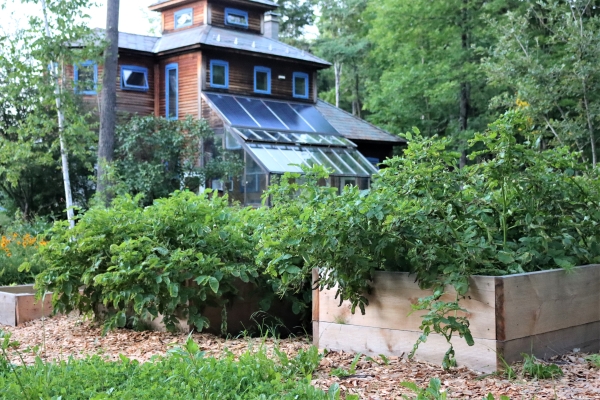
We then fill the remaining bed up with a mix of compost and the topsoil that was on the paths around the beds.
The paths are then backfilled with wood chips to prevent mud and keep down weeds. Over time, the wood chips in the path slowly decompose from the bottom up. We rake back the woodchips on the paths, peel up the fresh compost underneath and use it to top dress and “mulch” our raised beds.
Compost doesn’t contain weed seeds, and it’s an amazing mulch if applied at a depth of 2-3 inches over the top of the soil. By mulching with woodchip compost we are able to keep our raised beds virtually weed-free all year (without weeding)!
That means that we’re able to garden with minimal effort, once the raised beds and wood chipped paths are installed. We don’t water or weed our gardens, we simply deliver wood chips to the paths (and shovel composted wood chips on the beds) once a year.
Beyond that, it’s all harvest.

Growing Mushrooms with Wood Chips
Woodchips are a natural substrate for mushrooms, and once you have wood chips in the garden there will be mushrooms whether you like it or not.
You might as well try to direct the process a bit and harvest mushrooms as well as vegetables. This process can be a bit tricky, and I’d only suggest it if you’re confident you can learn to identify the mushrooms you’re growing (as opposed to others that may have just come in on the wind).
If you’re interested, I’d highly recommend the book Organic Mushroom Farming by Tradd Cotter, which takes you through everything you’d need to know to grow just about any type of mushroom under the sun.
We tend to keep things simple, and we only purposefully grow wine cap mushrooms (Stropharia rugosoannulata), which thrive in the full sun of a garden environment, are easy to identify and effortless to grow.
We grow wine caps with our strawberries, and they really thrive in companion planting.
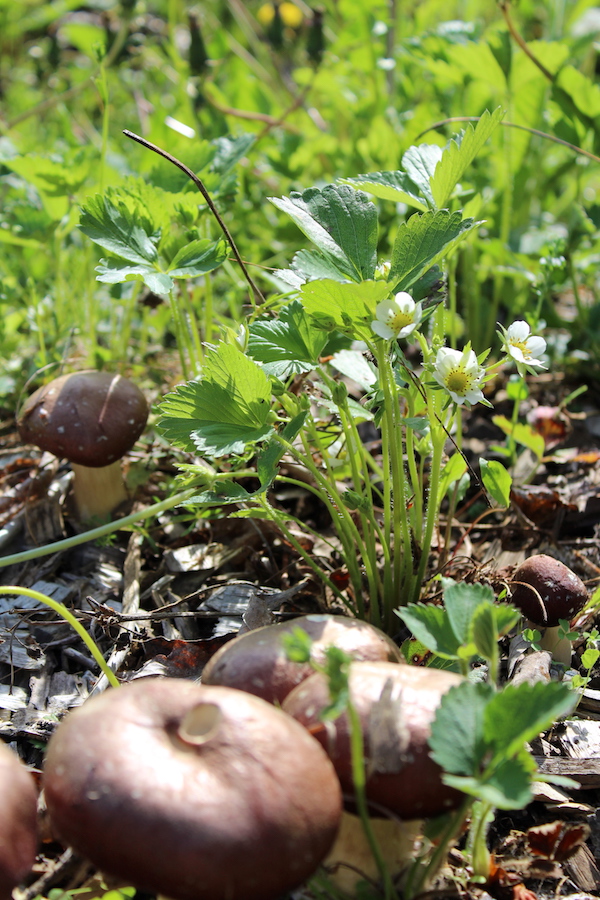
Downsides of Wood Chip Gardening
Gardening with woodchips isn’t all sunshine and full harvest baskets, there are challenges of course, as with anything.
Nitrogen Binding
Decomposing bacteria require a balance of carbon and nitrogen to do their work, so if add a huge carbon source they’re going to tie up nitrogen while they work to decompose the carbon in the wood. It’s important that the wood chips stay on the soil surface, rather than become incorporated into the soil.
In that way, they’re only tying up nitrogen right in the first few millimeters of soil. That will prevent weed seeds from germinating, but won’t harm deeper-rooted established plants.
Particle size is also important, and large particles in wood chips bind little nitrogen, while small particles in sawdust bind lots of nitrogen and should not be used.
Germination
With annual plants, nitrogen needs for seedlings can be tricky until they’ve gotten their roots down into the fertile soil.
This is one reason I don’t tend to use wood chips on my annual garden, and instead, use them on my perennial plants and then add wood chip compost as a mulch for my annuals.
pH
When woodchips are first applied they can increase soil pH temporarily, which can be a problem for acid-loving plants. Most plants don’t notice at all, but blueberries and other acid-loving plants are often set back by the first application of wood chips.
Using pine-based woodchips can help with this problem, as they don’t have the same effect. Pine needles, and to a lesser extent pine bark and wood actually lowers soil pH. Combine this with the slight pH raising effect of fresh wood chips and it’s about even with no effect on soil pH.
In the long run, blueberries thrive with wood chip mulch since they’re shallow-rooted and incredibly sensitive to soil moisture issues and grass competition. We mulch our blueberries with wood chips, but we know that big new applications of fresh wood chips should always be accompanied by a dose of pH-lowering fertilizer.
We generally use Organic Holly Tone, which we apply around the base of each plant every year anyway since our soils naturally have a neutral pH.
The biggest effect happens with the very first application, after that the wood chips beneath begin to decompose and it’s much less of an issue.
Runner Spreading Crops
Woodchips suppress weeds at the soil surface, but that also means they inhibit the rooting of runner-spreading plants. That’s great for inhibiting aggressive weeds like buttercup and crabgrass, but not so great for runner spreading plants you actually want in your garden.
Those are mostly groundcover plants, which slowly spread across the soil surface.
There are lots of ornamental groundcovers, but for my purposes with a permaculture food garden the main groundcover crops we gro are cranberries and lingonberries.
We mulch these low-growing acid-loving plants with a mix of compost and sand, and they thrive with that treatment.
Allelopathy
Most, but not all, woodchips are beneficial for the garden.
Avoid using woodchips from walnut trees (and walnut relatives like butternut trees). They produce a compound called juglone which inhibits the growth of most other plants.
Also avoid using woodchips for eucalyptus, as they also have inhibitory properties in their wood.
Labor
Honestly, the biggest problem with using woodchips in the garden is labor. It takes a lot of work to apply woodchip mulch for the first time.
Shoveling, then more shoveling…then even more shoveling…and finally you’ve got a good deep layer of wood chips available to suppress weeds and maintain soil moisture.
It’s a huge time investment upfront, but then most of the summer while others are bent over weeding their gardens I’m relaxing by the pond.
When Not to Use Woodchips in the Garden
For all these reasons, I generally avoid using mulch around:
- Annual plants with High Nitrogen needs. Examples include salad greens like spinach and lettuce.
- pH-sensitive crops need amendments to proactively lower the pH before the first woodchip application. Woodchips work really well with blueberries, so long as you apply sulfur or another acid source before the first woodchip application.
- Runner spreading crops don’t do well with woodchips because they can’t naturally spread as well with a thick woodchip layer. Examples include groundcovers like lowbush blueberries, cranberries, and lingonberries.
Even with these downsides, there are far more places where wood chips dramatically improve your garden yields while lowering work for the gardener. They can’t be used everywhere, but they do exceptional work in many places.
Provided you’re willing to spend a lot of time shoveling wood chips…
It’s a big commitment upfront, but it will virtually eliminate weeding down the road. Well worth it in my book.
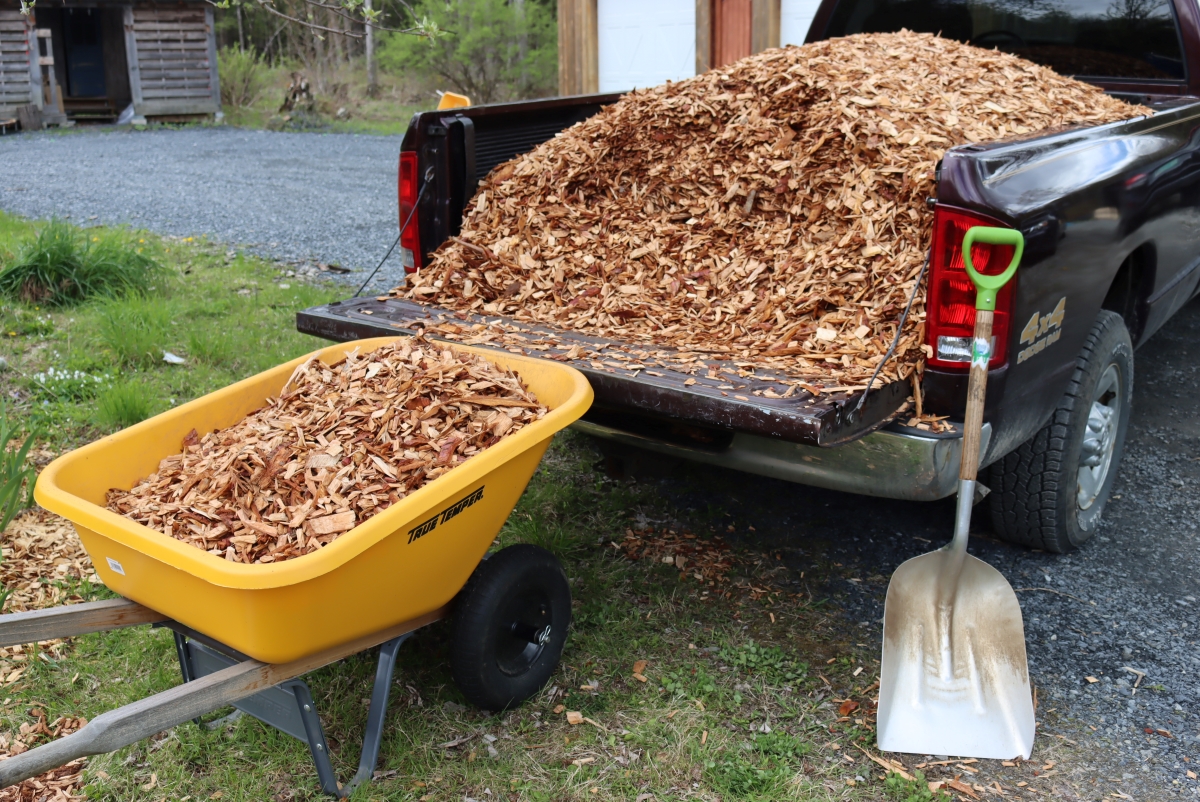
Where to Get Woodchips for Gardening
That’s the tricky part, isn’t it?
Woodchips are incredibly valuable for gardening, but where on earth is the average person to get them? Believe it or not, there are a number of good options.
Making Woodchips for Gardening
We grow a lot of our own food here, so it makes sense to produce our own woodchips from our woodland homestead.
We started off with a small home model wood chipper that worked well for chipping small limbs and trimmings. It was about 7 HP and said it could handle limbs up to 3”, but in reality, I’d say 2 1/2” is pushing it, and it’s best to stick with 2” or smaller limb trimmings with a chipper like that.
When we bought our tractor, we upgraded to a 5” PTO driven wood chipper and that can handle logs with a diameter a bit larger than my palm, or about as big as the average person can comfortably pick up and put into it. A single sapling from our woods will quickly fill a wheelbarrow with chips. (Literally, about 15 seconds from pole to chips.)
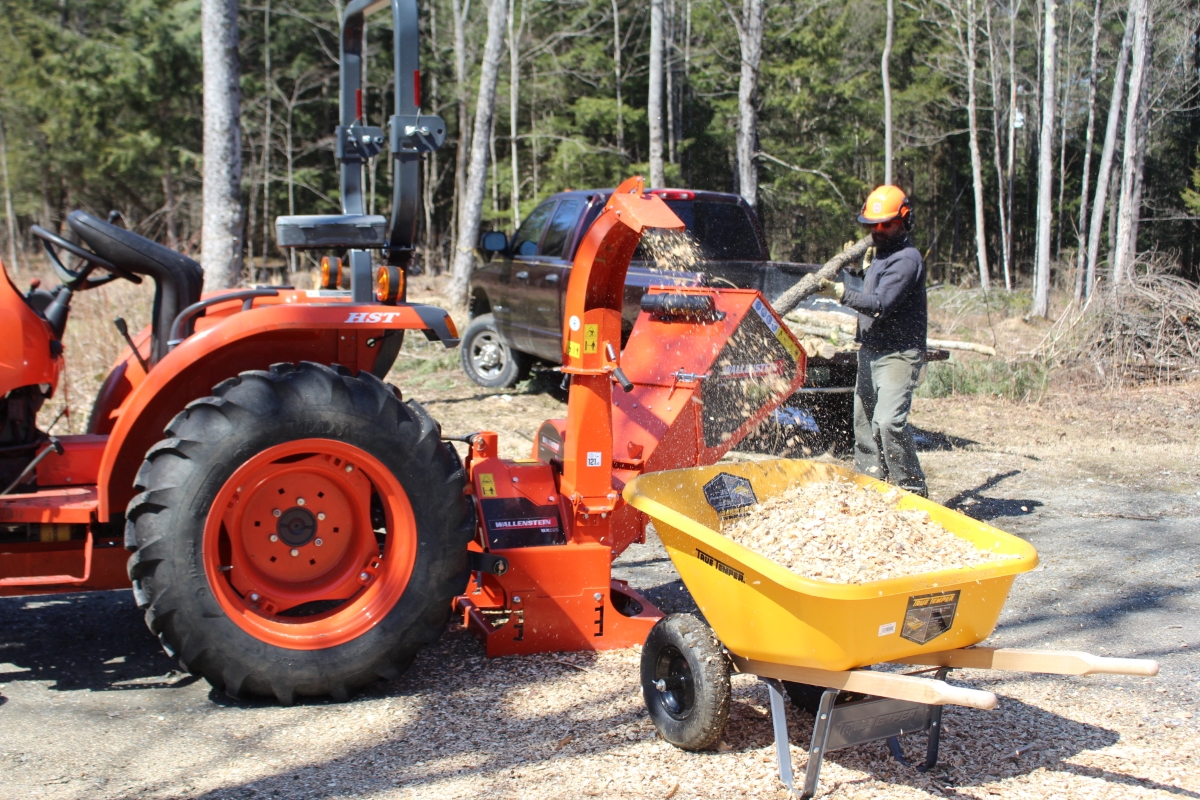
A PTO woodchipper is incredibly handy, and many mid-sized lawn tractors for homeowners have PTO attachments now. Not a bad investment if you plan on using a lot of woodchips, and you have any amount of woodland on your property.
(We use enough woodchips at this point that we’re planning on upgrading to a stand-alone Vermeer 10” chipper this coming year, so you’ll see even more wood chip gardening content to come…)
Wood Chips from Tree Services and Lumberyards
The other option besides chipping our own is to source woodchips from tree services or lumberyards. Around here tree services actually charge to deliver chips because they’re so incredibly popular for gardening.
Availability really depends on where you are, and A friend of mine in Maine who does Back to Eden Gardening is able to source them by the tractor-trailer load for free. Call around locally, and you may get lucky.
A local lumber mill also sells wood chips by the yard and will load them right into the back of your truck. We’ve gone to get truckloads on occasion when we can’t quite produce enough to cover newly established gardens. The price is pretty reasonable, $25 a yard.
(For comparison, bark mulch sells for around $60 a yard locally, and compost goes for $100 a yard…we’re in a “high cost of gardening” region…)
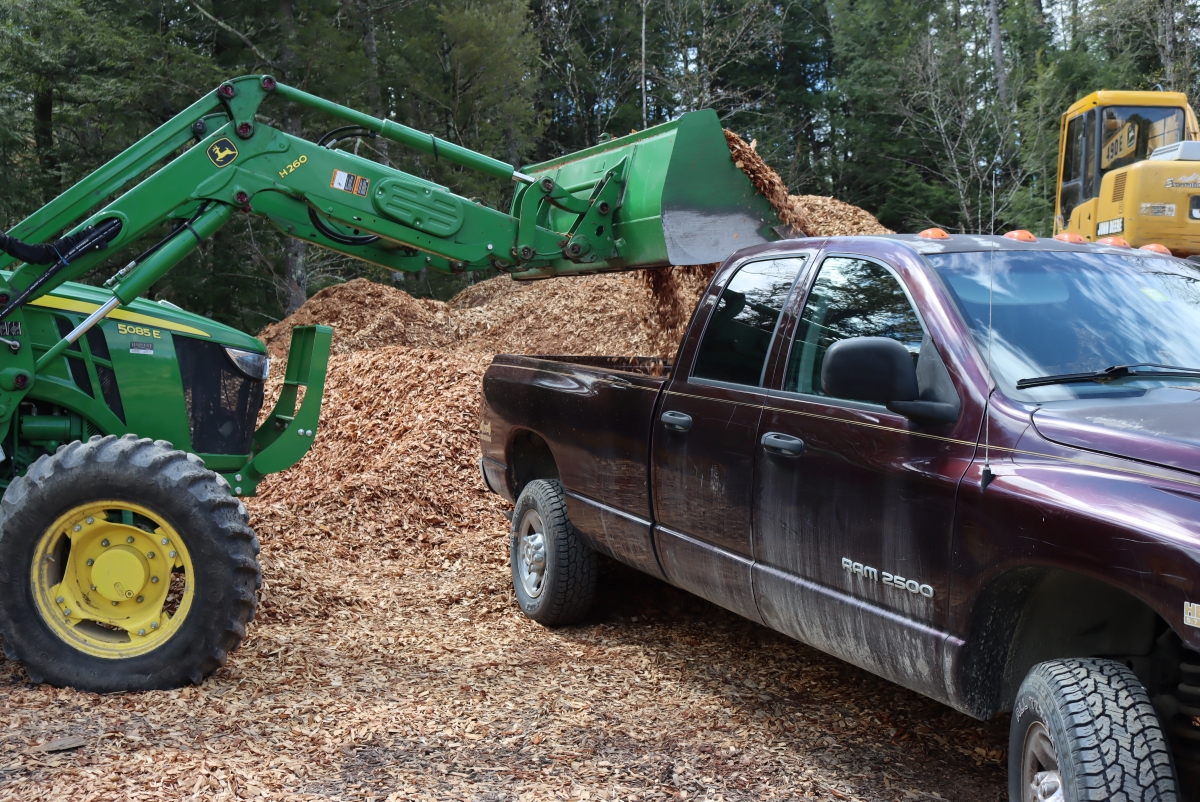
If you do purchase woodchips, be careful that you know your source. Some lumberyards will chip “waste wood” from demolition projects, and that may contain pressure-treated wood and other less desirable things that can be toxic to a garden.
Our lumbermill in particular only deals in local saw logs, so all the chips are clean, but that may not be the case everywhere.
Troubleshooting Woodchip Gardening
I realize I’m making this whole gardening with woodchips thing sound quite simple, and to some extent it is…but in other respects, it’s not.
Sometimes it really is just as simple as spreading out the woodchips under your apple trees every few years. In other cases, the choice of wood chip really matters.
The type of tree can make a difference, as does where the chip comes from on the tree. Sapwood and bark, for example, are more full of nitrogen, while the heartwood of the trunk is almost all carbon. Each has its own applications, and it can get pretty complicated.
Beyond that, you’ll occasionally run into issues that you need to troubleshoot. For example, fresh wood chips can temporarily raise the pH of soils…which is a problem around blueberries and other acid-loving crops.
This manifests, oddly enough, as an iron deficiency which you’ll see in the blueberry leaves. When the pH goes too high, blueberry plants cant uptake iron, and they get a characteristic yellow leaf with dark green veins (known as Chlorosis).
It’s horrifying watching your beloved blueberry plants turn yellow, and then you question whether woodchip gardening was worth it at all.
Trust me, it is.
In the case of blueberries, you just need to apply a burst of acid fertilizer (or pine needles and bark) under the wood chips to counteract the problems during the first application. After the first application of wood chips, you can keep top-dressing them with fresh wood chips without issue.
But, given that it can be more complicated than just tossing woodchips on the soil, I’d wholeheartedly recommend the book, The Woodchip Handbook which really dives into the specifics of gardening with woodchips and can help you through the more specific troubleshooting that you may require.
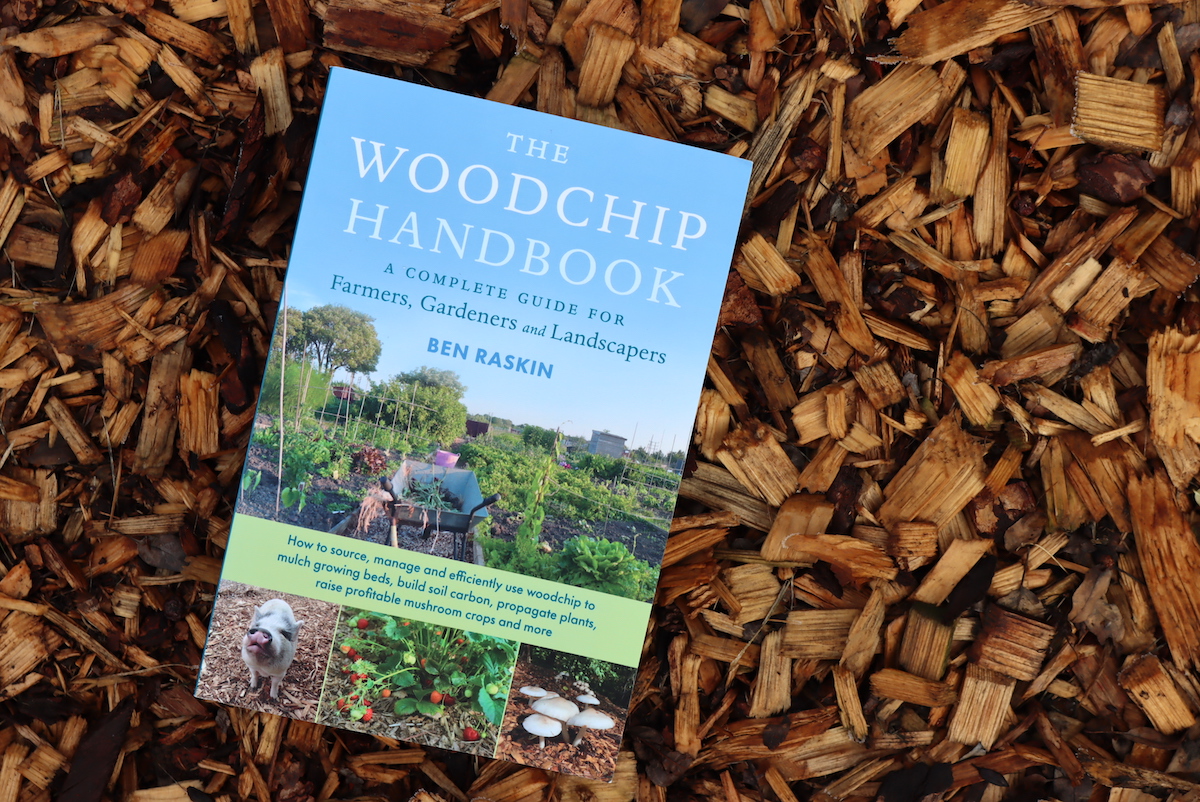
Gardening Guides
Looking for more gardening guides?
- 60+ Unique Fruits and Nuts for Cold Climates (Zones 3-5)
- Cold Hardy Nut Trees for Zones 3 to 5
- How to Grow Honeyberries
- Growing Strawberries from Seed
- Growing Apples from Seed
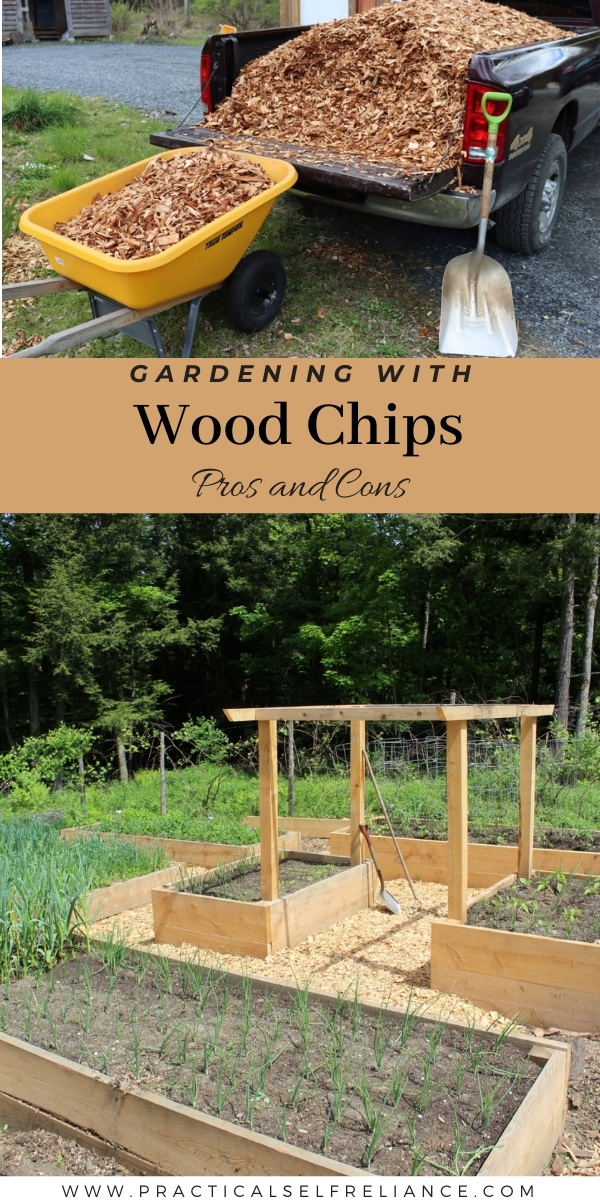
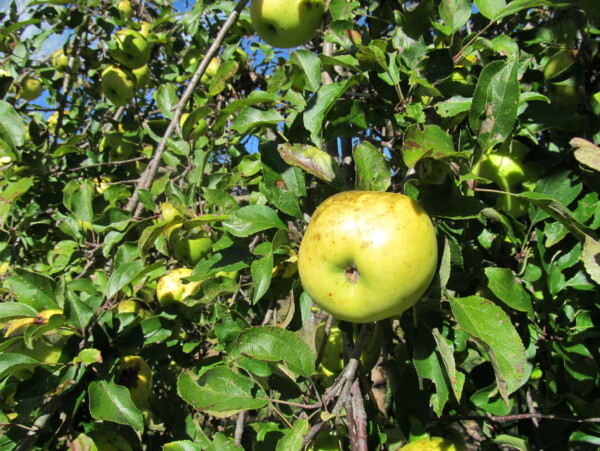



Great article. Provided the information I was looking for as I’m looking to turn a clay soil into a natural area. Thanks for sharing!
You’re very welcome. We’re so glad that you enjoyed the post.
https://getchipdrop.com is a free source of woodchips. Depending on your location/the time of year it can take forever, but my sister and another neighbour have had success with them in NW Oregon.